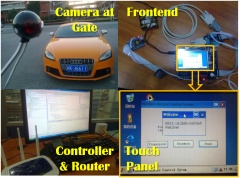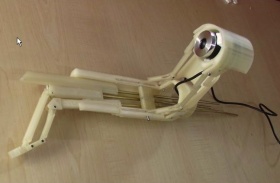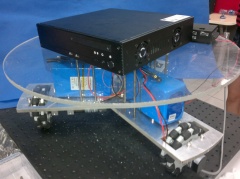From Rii
| Line 54: | Line 54: | ||
* George Dieter and Linda Schmidt, ''Engineering Design'', 4th Ed., 2008, McGraw Hill. | * George Dieter and Linda Schmidt, ''Engineering Design'', 4th Ed., 2008, McGraw Hill. | ||
<br/> | <br/> | ||
| + | == Sample Projects == | ||
| + | Sample projects from previous semesters can be viewed as follows. | ||
| + | {|border="1" | ||
| + | |align="center"|A Secure Access Control System | ||
| + | |align="center"|Design of an Endoscopic Stitch | ||
| + | |align="center"|An Omnidirectional Mobile Platform | ||
| + | |- | ||
| + | |align="center"|[[File: VM450_project1.jpg|frameless|240px]] | ||
| + | |align="center"|[[File: VM450_project2.jpg|frameless|280px]] | ||
| + | |align="center"|[[File: VM450_project3.jpg|frameless|240px]] | ||
| + | |- | ||
| + | |width=240px|The secure access control system enabled users to control their house gates wirelessly: users may enter their houses with fingerprint, password, and car license plate number, and identify visitors by image. The system consists of three components connected wirelessly: i) frontend with a camera and a GUI on ARM11 touch panel, ii) central controller to transmit and process data, and iii) client end on users’ mobile phones. The test results showed that the system automatically verified visitors successfully. | ||
| + | |width=280px|This project designs and builds a mockup of an endoscopic stitch, which could achieve stomach reduction surgery for obesity treatment. Considerations of the main specifications include safety, size, reliability, ease of operation and so on. An integration of subsystems has been designed: stitching system, threading system and light & camera system. By fine dimensioning, these systems have been enclosed in a tube. After the design is finished, function of the design is verified using a scaled model made by a rapid prototyping machine. | ||
| + | |width=280px|Modern hospitals have become more and more complicated and theor management now heavily relies on various medical information management systems. Although the information management is somehow automated, logistics is still handled manually in most cases. Unlike the settings in an industrial environment, a populated hospital can hardly use conveying belts and railed platforms to transport various medical supplies. An intelligent wheeled mobile platform is needed for delivery, prioritizing an updating schedule as well as assuring safe interaction with a dynamic environment. | ||
| + | |} | ||
Latest revision as of 08:43, 18 August 2011
Design and Manufacturing III
Course Objectives
The educational goal of VM450 is to give each student a deep understanding of how to approach open-ended challenges in a team environment and in a systematical way. Students will learn how to innovate and apply the seemingly fragmented engineering knowledge acquired at JI to design projects. The projects are often interdisciplinary requiring professional problem-solving methods and intensive group studies.
This course is to give each student an understanding of design principles and to teach the application, implementation and integration of engineering knowledge obtained at JI toward the design and manufacturing of mechanical electrical systems. Accomplishment of this goal will be measured through the successful completion of an open-ended design project with appropriate design reviews and corresponding reporting deliverables. At the end of the course, students are expected to:
- Solve an open-ended engineering design problem including considerations of performance, cost, social issues, etc. The problem must provide opportunities for creative design, fundamental analysis, and proof-of-concept prototyping. Each student team works on a project and everyone participates in project proposal development, reporting, and the design process.
- Apply a design process appropriate to the engineering problem at hand, including unstructured creativity as part of a structured design problem.
- Generate and evaluate design concepts after gaining a sound understanding of the problem background and existing design concepts.
- Identify a set of design variables and governing equations for the selected design concept that can be utilized to improve the design.
Course Outcomes
When this course is completed, students should be able to achieve the following:
- Given a qualitative and open-ended "real-world" engineering design problem, suggest a solution based on quantitative analysis.
- Learn to work effectively in engineering teams to resolve conflicts and meet specific engineering objectives established during the project. Learn to communicate effectively with peers, project sponsors, advisors, and/or mentors.
- Learn to consider unstructured creativity as a natural part of a structured design process, and to systematically generate concepts using methods such as brainstorming and decomposition.
- Learn to make good assumptions and exercise sound judgment in solving open-ended problems.
- Manage and plan design projects using time management tools, and be able to handle uncertain and incomplete information effectively to meet project goals.
- Learn to clearly request and exchange quantitative information, and to communicate project results, to audiences of varying levels of expertise.
- Learn patent and literature search methods, benchmarking, and other general forms of background independent learning.
- Integrate past course materials to advance basic system concepts to a prototyping level, providing support for all design decisions by defensible engineering analysis and reasoning.
Milestone and Deliverables
The schedule of deliverables intends to keep teams on track for a successful Design Expo demonstration of a functional prototype by the end of semester. In order to ensure the progress, each team is advised to schedule a weekly meeting with the sponsor and the section instructor, besides attending the scheduled lectures.
- In the first Design Review (DR#1), teams will have defined the engineering specifications for their projects, benchmarked the existing/competing products, identified the state-of-the-art, and generated some concepts.
- In DR#2, teams review their generated concepts and the concept selection. It is expected that the best engineering concept generated in this design review will require significant modification (and perhaps a new design altogether), driven by feedback from the section instructor or/and sponsor, as well as by experimentation and further analysis.
- DR#3 requires a final detailed design and drawings, ready for manufacturing the prototype. Any changes to the design after this point must be documented by an Engineering Change Notice (ECN) and communicated immediately with the sponsor and the section instructor. For those teams that follow the experimentation path, prototyping in the machine shop will likely begin shortly after DR#2. It should be noted that for all teams, machine shop access could only occur after drawings have been produced and reviewed by the machinist, and the sponsor/section instructor.
- DR#4 reviews the progress of the prototyping.
- The Final Prototype Review, Presentation and archiving the complete report will occur at the Design Expo.
In each of the Design Reviews, a business dress code will be mandatory.
Lectures
VM450 involves more than finishing a project. It teaches students how to approach a practical problem in a team environment and present results to interested parties. The lectures will provide approaches, knowledge, and tools that can be used by students as they progress from design to prototyping. At the same time, students will be assigned to groups of five that will work together for the entire semester on a single design project. Consequently, cooperative learning methods will be used during that time, which depend heavily on teamwork.
The lectures will cover how the engineering design can be approached as a process. These lectures will be applied directly to individual projects via discussions through worksheets, presentations, and meetings with the section instructor. The lectures will also cover topics not previously presented in core ME courses such as interactions with business and industrial leaders, environmental impact, materials and manufacturing process selection, entrepreneurship, and intellectual property protection, etc.
Attendance is required at each lecture/invited talk. Students are asked to check the box and sign next to your name on the sign-in sheet upon entering the classroom. All absences will need to be authorized by your Section Instructor.
Discussion and Meeting
Teams are advised to meet with the sponsor weekly and meet the section instructor bi-weekly to ensure progresses on track, besides attending scheduled lectures. The meetings and discussions are also a forum of interaction which is especially important at the beginning of the semester. The discussions and meetings also assure the application of the appropriate design process and/or the appropriate technical knowledge to the projects by reinforcing lecture materials.
Attendance of all the team members is expected at each discussion section and/or meeting. This is especially important as participation in the discussion sections will form a significant portion of your participation grade, along with lecture participation. Peer reviews will be conducted corresponding to each design review, to solicit your opinions regarding the energy, professionalism, and enthusiasm of your teammates. The Section Instructors will weigh this input seriously as participation grades are determined.
Prerequisites
The main requirement for VM450 is VM350: Design and Manufacturing II and VM395: Laboratory I. You are expected to have a good working knowledge of elementary mechanics such as statics, dynamics, and strength of materials. For example, you should be able to draw free body diagrams and determine such quantities as loads, deflections, and stress distributions across sections of mechanical components due to bending, torsion, shear force, etc. You are also expected to have basic machining skills and be authorized to use the machine shop.
Textbook
Lecture notes will be available along with a number of general resources that will facilitate the application of a design process to your project. A reference textbook for the course is:
- George Dieter and Linda Schmidt, Engineering Design, 4th Ed., 2008, McGraw Hill.
Sample Projects
Sample projects from previous semesters can be viewed as follows.


